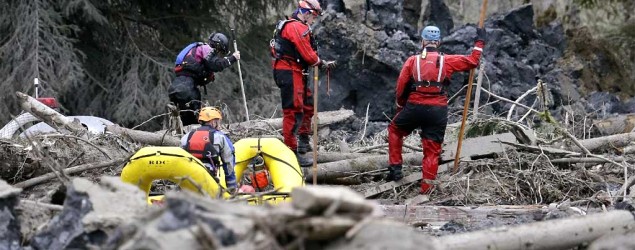2 more bodies recovered from Washington mudslide

ARLINGTON, Wash. (AP) — Rescuers slogging through muck and rain Tuesday in an increasingly desperate search for survivors of a massive mudslide instead recovered two bodies and believe they have located another eight, Washington state officials said.
The official death toll rose to 16, with the possibility of 24 dead once the other bodies are confirmed, Snohomish County District 21 Fire Chief Travis Hots said.
The grim discoveries further demoralized the four-day search, as the threat of flash floods or another landslide loomed over the rescuers. With scores still missing from the slide that tore through a rural community north of Seattle on Saturday, authorities were working off a list of 176 people unaccounted for, though some names were believed to be duplicates.
That number will change because the power to the nearby logging town of Darrington was restored and more people have called in. An updated number would be available Wednesday, Snohomish County Emergency Department director John Pennington said.
"We're all still hoping for that miracle but we are preparing for the other possibility," Washington State Patrol spokesman Bob Calkins said Tuesday afternoon.
With the developments came word that a scientist working for the government had warned 15 years ago about the potential for a catastrophic landslide in the community.
The 1999 report by geomorphologist Daniel Miller raises questions about why residents were allowed to build homes in the area and whether officials had taken proper precautions.
"I knew it would fail catastrophically in a large-magnitude event," though not when it would happen, said Miller, who was hired by the U.S. Army Corps of Engineers to do the study. "I was not surprised."
Snohomish County officials and authorities in the devastated rural community of Oso said they were not aware of the study. The Seattle Times first reported on Miller's analysis.
But Pennington said local authorities were vigilant about warning the public of landslide dangers, and homeowners "were very aware of the slide potential."
In fact, the area has long been known as the "Hazel Landslide" because of landslides over the past half-century. The last major one before Saturday's disaster was in 2006.
"We've done everything we could to protect them," Pennington said.
Patricia Graesser, a spokeswoman for the Army Corps of Engineers in Seattle, said it appears the report was intended not as a risk assessment, but as a feasibility study for ecosystem restoration.
Asked whether the agency should have done anything with the information, she said, "We don't have jurisdiction to do anything. We don't do zoning. That's a local responsibility."
No landslide warnings for the area were issued immediately before the disaster, which came after weeks of heavy rain. The rushing wall of quicksand-like mud, trees and other debris flattened about two dozen homes and critically injured several people.
"One of the things this tragedy should teach us is the need to get better information about geologic hazards out to the general public," said David Montgomery, a geomorphologist and professor with the University of Washington in Seattle.
A volunteer was injured Tuesday when he was struck by debris blown by a helicopter's rotor. The man was transported to a hospital for evaluation, but the injuries appear minor, Snohomish County sheriff's spokeswoman Shari Ireton said in a statement.
Near the southern perimeter of the slide, volunteers from a logging crew gathered to help move debris with chain saws, excavators and other heavy equipment.
Gene Karger said he could see six orange flags in the debris field, marking bodies they would be pulling out. Karger, a logger most of his life, said it was the first time he was involved in this kind of rescue work.
"You see parts of their bodies sticking out of the mud. It's real hard. It's that bad," Karger said. "There are people out there we know."
Hots said about 200 responders using everything from heavy equipment and search dogs to their bare hands were working through the debris field Tuesday in rainy, wet conditions.
"We didn't locate anybody alive," he said. "We haven't lost hope that there's a possibility that we can find somebody alive in some pocket area."
In his report, Miller said the soil on the steep slope lacked any binding agent that would make it more secure, and that the underlying layers of silt and sand could give way in a "large catastrophic failure."
But he also cautioned: "I currently have no basis for estimating the probable rate or timing of future landslide activity."
In an interview Tuesday, Miller noted there are hundreds of similar landslides in Washington state each year, and this particular river valley has had three very large slides in the last three decades.
Predicting landslides is difficult, according to a study published by the U.S. Geological Survey in 2012. One challenge is estimating the probability of a slide in any particular place.
Homeowners insurance typically does not cover landslide damage, but customers can purchase such coverage, said Karl Newman, president of NW Insurance Council, a trade group in the Northwest.
One of the authors of the USGS report, Jonathan Godt, a research scientist with the agency in Colorado, said landslides don't get that much attention because they often happen in places where they don't hit anything.
But with Americans building homes deeper into the wilderness, he said, "there are more people in the way."
___
Le reported from Seattle. Associated Press writers Jason Dearen in San Francisco; Lisa Baumann in Seattle; P. Solomon Banda in Darrington, Wash.; and photographer Elaine Thompson in Oso, Wash., contributed to this report. Researcher Rhonda Shafner contributed from New York.
No comments:
Post a Comment